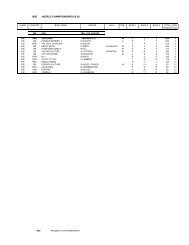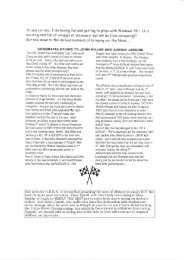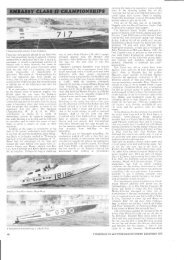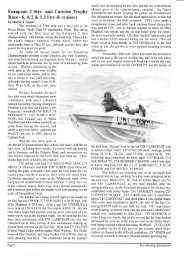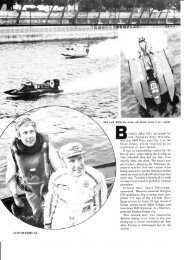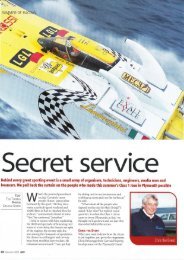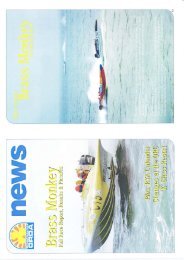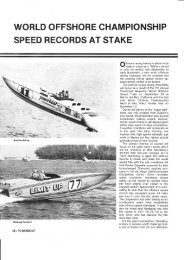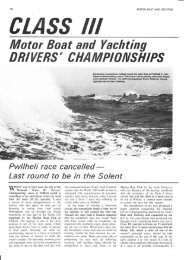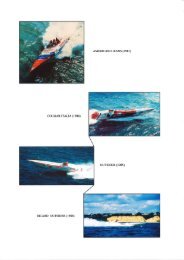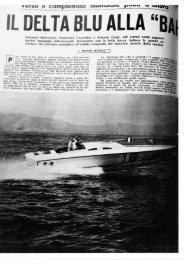&e - Powerboat Archive
&e - Powerboat Archive
&e - Powerboat Archive
Create successful ePaper yourself
Turn your PDF publications into a flip-book with our unique Google optimized e-Paper software.
C5<br />
I<br />
=<br />
c)<br />
E<br />
92<br />
full{ime secretariat, access to almost unlimited<br />
water and large membership, have come to<br />
expect more than one National Championship<br />
round to supplement their own series. At the<br />
other, clubs such as those at Wallasey and<br />
Pwllheli, the Offshore Racing Drivers Association<br />
and the Royal Southern Yacht Club feel<br />
aggrieved if they do not get at least one.<br />
Given the current Charnpionship make-up, the<br />
balancing act just works, but the number of<br />
entries for each event may suffer. On the other<br />
hand if the number of rounds is reduced the<br />
chances are that the non-championship races<br />
will cease to be staged, for what club wants to<br />
take the financial gamble of putting on an event<br />
with less status?<br />
UKOBA are in the strongest position: such is<br />
their membership and following that they could<br />
run a championship of their own which might<br />
actually be more attractive than the National<br />
alternative. However, this would not augur well for<br />
continuity or good relations.<br />
The ORC may have to find a compromise, The<br />
big test of everyone's resolve is whether<br />
decisions can be taken with the best overall<br />
interests of the sport in mind.<br />
Meanwhile, out on the water, life has also been<br />
tough for the competitors. lf ever offshore racing<br />
in this country needed a smooth send-off to a<br />
season, and an easy introduction for newcomers,<br />
1993 was that season. lnstead, it got one rough<br />
race, one very rough race and one so rough that<br />
jt never took place at all. The entry lists for all<br />
three looked simrlar.<br />
Not since the end of 1989 has British domestic<br />
racing managed to field more than two<br />
indigenous Class I contenders, and 1993 is no<br />
different. The only true Class I boat rs Roger<br />
Fletcher's 50ft (15.2m) aluminium Shead<br />
monohull Shockwave, and the only interest<br />
concerns whether his plans for improving its<br />
performance will bear fruit.<br />
The triple Sabre diesel-powered boat has<br />
never had its potential fully exploited, due partly<br />
to the crew's penchant for running fully ballasted<br />
at all times and partly to its less than precise<br />
handling in the turns.<br />
Two rudders have now given way to a single<br />
blade mounted in the middle, and the latest ploy<br />
to ease the beast further over the drag hump is a<br />
laterally-mounted hydrofoil just ahead of the step.<br />
Opinions have polarised between those who feel<br />
this device might lift the bow and plunge the<br />
heavy end deeper, thus reducing speed, and<br />
those who feel that it might lift the stern so much<br />
that the keel towards the bow becomes the<br />
rudder, thus making it undrivable!<br />
Class ll is numerically stronger and sports the<br />
only boat new to British racing, Charles Burnett's<br />
28ft (8.5m)Skater. Previously raced in the USA,<br />
though not very hard, the cat could run with either<br />
two or three outboard motors. Burnett has<br />
favoured a twin Mercury installation, which is still<br />
capable of tickling 100mph and planing on one<br />
engine.<br />
Watching closely has been David Allenby,<br />
whose 36ft (10.9m) Donohoo design, with its four<br />
Mercurys, has hitherto been the boat to beat<br />
-<br />
provided he has been able to keep them all<br />
running, which he usually hasn't.<br />
After this year's Spithead Trophy and Southern<br />
Speed Trophy races, the score was Allenby two,<br />
Burnett nil. In fact, with Richard Windmill<br />
choosing to run his old Sabre-powered GRP<br />
monohull (the former Rejuga) in Class l, where it<br />
is grossly outclassed, and Martin Mansbridge still<br />
struggling to master the old Robin Hood Racing,<br />
now with canopies, Class ll has yet to see more<br />
than one boat f inish. lt does not exactly look like<br />
the great development class that it might be.<br />
Class lll, of course, is a different matter. Britain<br />
boasts the best designers, builders, riggers and<br />
drivers in the world in the 2-Litre and 4-Litre<br />
divisions, and it shows<br />
You want convention? We can give you<br />
convention. Phantom, Marshan, Forgecraft,<br />
Younger and Frode all have useful monohulls,<br />
and John Miller, John Billington and Steve Hore<br />
ran away with 2-Litre at Spithead, all driving 23ft<br />
(7m)GRP Frodes.<br />
You want innovation? We can give you<br />
innovation, too. Even in the absense of Neil<br />
Holmes' trimaran in 4-Litre, the Campbell/Midas<br />
combination have Tony Jenvey's superlight,<br />
superlong 27fI(8.2m) GRP composite cat, which<br />
won its class in the Southern Speed rough, and<br />
Miller and Robin Parrish are to take delivery of<br />
rdentical boats which will ooen up the<br />
competition still further<br />
In 1 .3-Litre, the exception to the monohull rule<br />
is Peter Wilson's 17ft (5.1m) Argocat. but the<br />
conditions have to be right for him. So far this<br />
year, they haven't been. In the Southern Speed,<br />
even Geoff Bird's Phantom 16 suffered in the<br />
conditions and may not be repairable; the<br />
Graysons, who won at Spithead, opted out before<br />
the start,<br />
The Cruiser class seems to have run out of<br />
steam again. When you talkto long-time<br />
competitor and regular winner Alan Webb, a<br />
picture emerges of disaffection with increasingly<br />
stringent rules and a class hit harder than any<br />
other by the recession.<br />
It is this kind of testament which may convince<br />
the ORC that their only sensible course of action<br />
is to reduce the number of rounds in allthe<br />
National Championships for 1994. Four races for<br />
Classes | , | | and Cruisers and eight for Class ll I<br />
would perhaps be appropriate. But it isn't quite<br />
that simple.<br />
The more British national activities are<br />
reduced, for whatever reason, the narrower<br />
becomes the country's powerbase<br />
internationally. With Europeans already<br />
questioning why Britain demands a Grand Prix<br />
when it has no boats and no drivers on the Class I<br />
circuit, the RYA's position is becoming parlous,<br />
Clearly, times are changing. The face of the<br />
sport has been transformed within the past two<br />
years, and older values are being challenged by<br />
the day. A possibility now being discussed<br />
openly in some circles is that in future Classes ll<br />
and lll might be used for Nationaland European<br />
championships, with CIass I reserved for World<br />
competition only.<br />
lf that came to pass, some of the current<br />
problems facing the ORC would be self-solving,<br />
and would pale into insignif icance beside that of<br />
how to keep Britain in an administrative driving<br />
seat at international level.<br />
It would behove the members of the ORC to<br />
look further than the end of their noses and<br />
devise a course of action to strengthen British<br />
racing over the long term. lf they don't, it will not<br />
be just the early races but the country's whole<br />
future in the sport which is under the weather. I<br />
MOTORBOATS MON.rHLY




